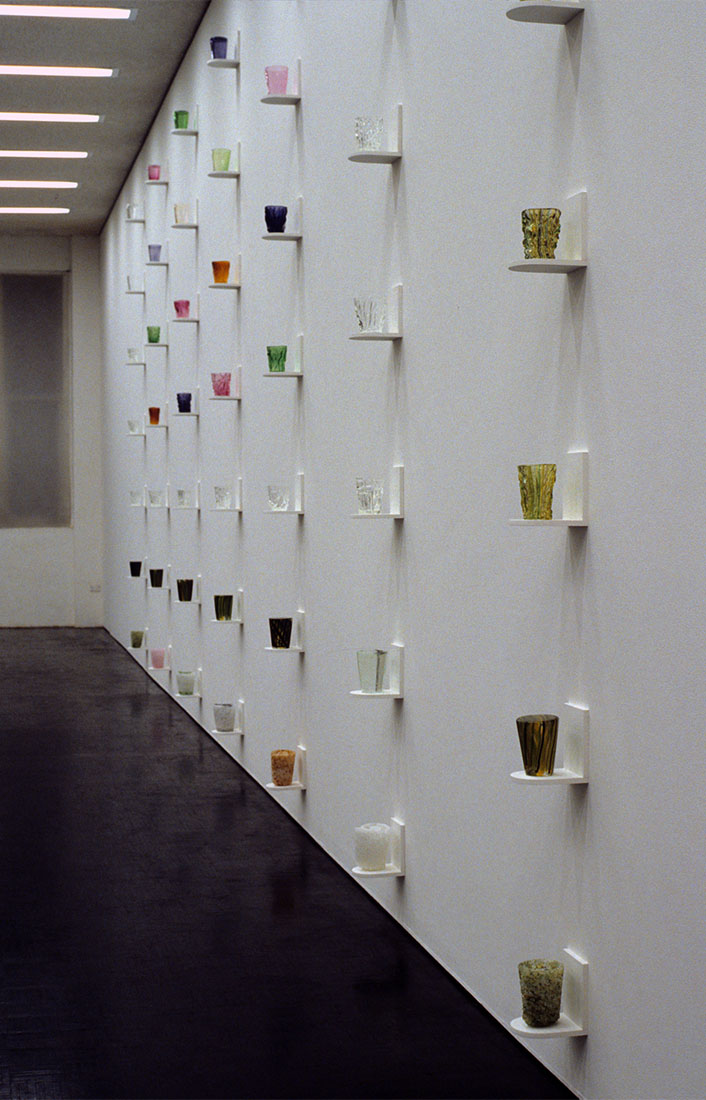Catchment, a field of beakers for Saint Hedwig of Silesia and for Wingecarribee Swamp, Mori Gallery. 2000
Toni Warburton
catchment a field of beakers for St Hedwig of Silesia and for Wingecarribee Swamp
31 January – 24 February 2001
The austerities of Saint Hedwig (d 1243), Queen and patron saint of Silesia, were assisted by her moulded and cut gloss beaker. The Hedwig beaker attained the status of a relic as it had the miraculous property of making ordinary water taste so pure that it seemed like on exquisite wine.
Peat, an ancient and essential purifying filter for wetlands, was dredged from Wingecarribee Swamp in the Southern Tablelands of New South Wales under the cynical jurisdiction of a mining lease, despite ten years of public outcry. This removal of port of its structural fabric weakened the entire peatland and in 1998, after heavy rains, most of the swamp collapsed This ecological disaster also compromised the local drinking water.
Wingecarribee Swamp is the habitat of the giant dragonfly, Petulara gigantea, as well as rare and endangered species of wetland plants. These hove so for managed to survive, and the swamp has been recognised as a wetland of national significance.
Transparency is air and potable water; emerald green, living plants. Indigo is the colour of reed filled water and the night; rose, the calm down light. Amber is dried grosses and tea tree stained swamp shallows. All five colours ore in the iridescence of sunlight on the wings of dragonflies.
“In mechanics, ‘the smaller dominates the larger,’ says Aristotle. This is atopon and thaumasion: having no place, and giving surprise. The reversal of forces opens a pathway through the impasse of a relation of forces that is unfavourable to man and favourable to nature. A trap that cannot be used twice. Machination opens up a capricious temporality, made of opportunities, discontinuous and ephemeral ones, a temporality that the Greeks named kairas, the right moment, the favourable instant. The opportunist machine is necessarily a soft machine.” From Machinations in Duchamp’s TRANS/formers, John Francis lyotard pp 42-43
The mould itself is a kind of trap into which the molten glass is folded I conspire with the gaffer to snore objects in small cones of material and time, to catch the muse, an energy that mobilises matter in response to intention. Vectors of chora, elusive muse of becoming, digress and converge, veil and illuminate penumbrations of matter, technique and catchment. However, once matter is mobilised, extra things, other things beyond the scope of intention happen These ore what the traps ore for. Such moments present the unfolding of pragmatic reality. Interception of such moments closes the trap in acts of mindful craft Each time a new trap is set a mould imprints its particular pattern and shatters into fragments.
Toni Warburton, January 2001
Links & Downloads
Means of production – Hot glass mould blowing
Exhibition Catalogue: Catchment, a field of beakers for Saint Hedwig of Silesia and for Wingecarribee Swamp, Mori Gallery. 2000
Toni Warburton, Catchment, unpublished Master of Visual Arts Dissertation, Sydney College of the Arts, University of Sydney Library



